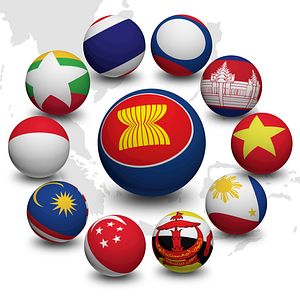Over the weekend, China’s foreign minister announced in Laos that Beijing had reached a four-point consensus with three of ten countries of the Association of Southeast Asian Nations (ASEAN) on the South China Sea.
According to Xinhua, Foreign Minister Wang Yi told a press conference in Vientiane on April 23 that China had reached a four-point consensus with Brunei, Cambodia and Laos on the South China Sea issue.
Specifically, Wang said the four countries agreed that the South China Sea disputes are not an issue between China and ASEAN as a whole and thus should not affect the development of the ASEAN-China relationship. They also agreed on the right enjoyed by sovereign states to choose their own ways to solve disputes; that there should be no attempt to unilaterally impose an agenda on other countries; that territorial and maritime disputes should be resolved through consultations and negotiations by parties directly concerned; and that China and ASEAN should be able to maintain peace and stability in the South China Sea through cooperation, with countries outside the region playing a constructive role in that regard.
The four-point consensus should be read as part of China’s broader attempt to secure diplomatic support from states on the South China Sea ahead of the verdict on the Philippines’ case against Beijing at The Hague expected in May or June (See: “Does the Philippines’ South China Sea Case Against China Really Matter?”). Wary of a string of statements from concerned actors directed against China following the verdict, Beijing has begun a diplomatic campaign to demonstrate that there are in fact states that agree with its South China Sea position in spite of its growing assertiveness.
China’s quest to secure a four-point consensus was well-coordinated: it came after Wang’s three-nation visit to Southeast Asia which included Brunei, Cambodia and Laos. The effort Beijing has put into getting this consensus also reveals that while it has displayed a willingness to bear significant reputational costs for its South China Sea actions thus far – including constructing a string of artificial islands as well as moving towards militarizing them – it does in fact care about its diplomatic position as well.
With respect to ASEAN more specifically, the move is just the latest sign that China is willing to exacerbate splits within the regional grouping on the South China Sea in order to secure the diplomatic support that it desires. As I have noted previously, though ASEAN does have a South China Sea position, it is also true that the grouping is comprised of a range of views on the question from different groups of states – not just between the four claimant states, interested parties, and not-so-interested parties like Cambodia, but even within these groups as well. For instance, among the four ASEAN claimant states, the Philippines and Vietnam are the two most forward-leaning claimants, while Brunei has been the quietest (See: “Does ASEAN Have a South China Sea Position?”).
China has a proven track record of exploiting divisions within the grouping to secure its interests on the South China Sea, as evidenced by its role in ASEAN’s unprecedented failure to issue a joint communique for the first time in its 45-year history during a summit in Cambodia back in 2012 (See: “ASEAN’s Soul-Searching After Phnom Penh”).
True to form, this time has secured a four-point consensus with the three ASEAN states that are already the closest to its own South China Sea position. Cambodia’s prime minister, Hun Sen, has long been famous for articulating pro-China statements on the South China Sea, including the myth that ASEAN does not have a South China Sea role at all (As I indicated previously, ASEAN does indeed have a position, even if it is a lowest common denominator one which is the product of consensus between all ten countries). Laos and Brunei have both also displayed a willingness to downplay the South China Sea issue in spite of Beijing’s assertiveness. Laos is not a claimant in the South China Sea disputes, and Brunei, while a claimant, is the only one among the claimants that does not occupy a single feature and has already largely preferred to deal with the issue bilaterally.
Of the three ASEAN states which were part of China’s four-point consensus on the South China Sea, Laos is the most immediate concern since it is chairing ASEAN this year. The worry is that ASEAN could see another split on the South China Sea question that would weaken the grouping, even if it is not as disastrous as the one witnessed in Phnom Penh back in 2012. In that vein, all eyes will be on Laos in the next round of Asian summitry that it will host in Vientiane later this year to see how it handles the South China Sea issue.

































